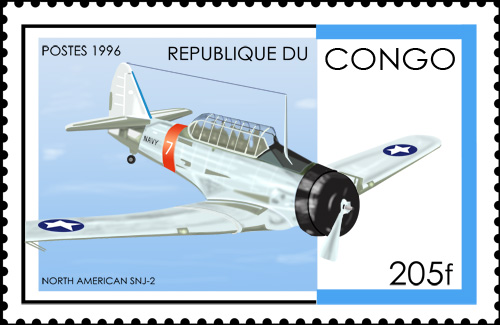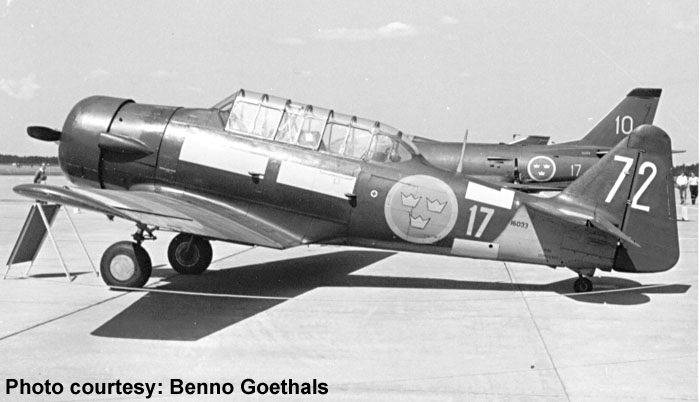|
|
||||
|
Sk 16 - North American/Noorduyn Harvard/Texan (1947-1972) |
||||
|
|
Page 1 (6) |
|||
|
|
||||
|
|
||||
|
More
than 17.000 airframes in different variants and under a multitude of
designations were built. It was without competition the most important
trainer of the Western Alliance during the WWII. The type was designed by
North American and the first prototype of this all-metal, cantilever
low-wing monoplane flew in 1935. This first version had two open cockpits
and fixed landing gear. The
design was further developed with a glazed enclosure over the cockpits.
The tailwheel remained fixed, but the main landing gear was now inward
retracting.
As a standard engine, the
relatively strong Pratt & Whitney R-1340 Wasp engine, delivering
around 600 hp, was chosen. This version of
the aircraft was ordered by the USAAF and US Navy, designated AT-6
Texan and SNJ respectively. The name Texan was applied to the aircraft
built in Dallas and was retroactively applied to all aircraft built in the
other production plant, which was located at Inglewood, California. The
RAF and the Commonwealth air forces operated the aircraft in large numbers
under the designation Harvard. Many aircraft were manufactured under
license in Canada and Australia. Improved and specialised models were
built up to the T-6F, SNJ-6 and Harvard Mk 4 variants. In
the late forties and early fifties almost 2000 early model T-6s were
remanufactured, and received the designation T-6G. They came from USAF and
USN stock, but also from the civilian market. They had been sold (almost
given away !) by the military arms only a few years earlier, but were now
badly needed for the USAF training as the introduction of the replacement
of the T-6, the T-28 gave problems. The
Swedish Air Force totally procured 257 Sk 16s. The designations of all kinds can make the whole thing a bit
complicated at first sight! -145
Harvards, manufactured in Canada by Noorduyn as the AT-16
(which is a development of North American’s designation
NA-77) were shipped to Sweden in 1947.
(In fact only 144 were manufactured in Canada; Fv 16145 was a
US manufactured former RCAF machine !).
The surplus market was
flooded with aircraft, so these first aircraft were bought to a very
favourable price although the running time in general was very low (or
nearly none). The aircraft in this first batch got the sub-designation Sk 16A with the Air Force numbers 16001-16145. -112
aircraft were purchased in 1950. Now the stock of surplus aircraft was
more limited. As
mentioned above, T-6s were being remanufactured as T-6Gs.
The running time of the
aircraft in this second batch was considerably longer. 106
were of the variants AT-6A, -B, SNJ-3, SNJ-4 (Sk
16B) and 6 of the naval variant SNJ-2 (Sk
16C). Air Force numbers 16201-16312. Most
of the Sk 16s were naturally provided to the Air Force Flight Academy (F 5) at
Ljungbyhed, but they flew also at all other Wings of the Air Force. Except
for training, they were used for weather flying and liaison. All aircraft
were fitted with the Pratt & Whitney R-1340-AN-1 air-cooled radial
engine of 600 hp.
Photo
at
top:
of Sk 16A (Harvard IIB, Noorduyn AT-16ND, SwAF/n, 16109 preserved
and displayed at Flygvapenmuseum. It was built in 1942 in Canada and is
ex-RCAF FE632. Construction number 14-366. Sk
16A: Length: 8,84m . Span: 12,81 m. MTOW: 2.400 kg. Max. speed: 290 km/h. Many thanks to Benno “T6” Goethals, , Rijen, the Netherlands, for helping me with this text! Download Benno Goethals detailed list of all Swedish Sk 16's as a zipped Excel-file. JUST CLICK HERE! |
||||
|
For the Model Builder
Heller has produced a
classic plastic model kit of the T-G6 Texan in scale 1:72. You have to get
Swedish decals to build model of Sk 16, but such decals sold by many
web-shops. Heller catalouge number 276. |
 |
|||
|
|
||||
|
|
||||
|
This stamp from the Republic of Congo depicts a North American SNJ-2 (SK 16 C in the Swedish Air Force). The stamp was issued in 1996. |
||||
|
|
||||
|
|
||||
|
|
Sk 16A # 16033 (Harvard IIB, Noorduyn AT-16ND). C/n 14-772. Ex. RCAF FH138. Markings of Air Force Wing F 17 at Kallinge near Ronneby. Now on display at Svedino’s Automobile and Aviation Museum at Ugglarp near Falkenberg, in the original markings of the War Flying School (F 5) at Ljungbyhed. Photo by Lars E. Lundin at F 17 1st of June, 1969. | |||
|
|
||||
|
|
||||
|
|
||||
|
|
||||
| © Lars Henriksson |
Updated 2010-08-04 |
|||
|
Custom Search
|
||||


